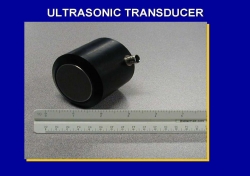Ultrasonic

The ultrasonic test method is a good technique for evaluating grout condition, fracture of elements, and abrupt changes in the element cross-section. The method has many of the features of the sonic echo technique, except that the transmitted signal contains relatively higher frequencies. Ultrasonic waves are radiated when an ultrasonic transducer applies periodic strains on the surface of the test object that propagate as stress waves. Compression waves consisting of alternating regions of compression and dilatation propagate along the axial direction of a rock bolt. Equipment required for the test includes a pulse source/receiver unit, an ultrasonic transducer, and a data acquisition system.
The ultrasonic transducer is acoustically coupled to the exposed end of the anchor rod. Grease is used as an acoustic couplant. The time taken for sound pulses, generated at regular intervals, to pass through the specimen and return, is measured. Return pulses may be either from a single reflection at a discontinuity, or from multiple reflections between a discontinuity and the end of the specimen. The patterns of the received pulses can provide valuable information about the nature of a defect, and of the structure of the material being tested. The advantage of the pulse-echo method is that only one side of the specimen needs to be accessed for transducer placement.

